Xtreme Vogue London Desk: Sarah Marshal
In a silent cove just above the Antarctic Circle, the Collins glacier, a towering slab of ice scored with folds and crevasses, creeps towards the Southern Ocean.
Apart from the groans of the ancient ice sheet, only the muffled flipper sounds of chinstrap penguins break the silence as fat snowflakes drift to the ground. Occasionally, one bird squarks and breaks from the huddle to slip noiselessly below the surface of the water, mottled with shards of ice.

An hour’s Zodiac ride from the Collins glacier, Escudero base sits at the head of a wide pebble beach streaked with penguin excrement, giving it an acrid, fishy smell that cuts through the biting wind. Offshore, queues of tourist cruise liners stalk the busy harbour.
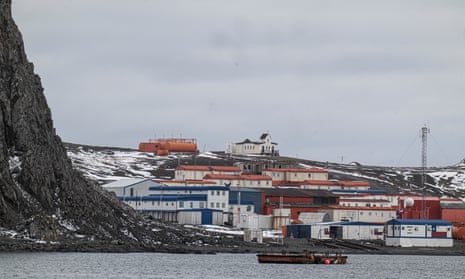
For generations, Antarctica’s alluring fragility, silence and wildness have drawn explorers, scientists and opportunists to the far south of the globe.
But as 2023’s summer season ends and daylight hours dwindle, the continent faces an uncertain future. The climate crisis, geopolitical upheaval far from the Antarctic, a burgeoning tourism industry and an ever-extending list of interests and actors are straining relations in the far south.
“Antarctic governance and geopolitics are in a very, very sensitive state at the moment,” said Dr Klaus Dodds, a professor of geopolitics at Royal Holloway, University of London.
The Antarctic treaty system (ATS), signed in 1959 and in force since 1961, defines everything below 60° south latitude as a place devoted to “peace and science”. Fifty-six states are party to the treaty, 29 of which have voting rights on matters related to the continent. Seven nations claim portions of Antarctica, but the ATS freezes all current and future claims.
But while the idealistic foundations of the treaty have held firm for more than six decades, the confluence of factors – from Russia’s invasion of Ukraine to tourism, and from mineral exploitation potential to new marine protected areas – have resulted in tensions bubbling to the surface.
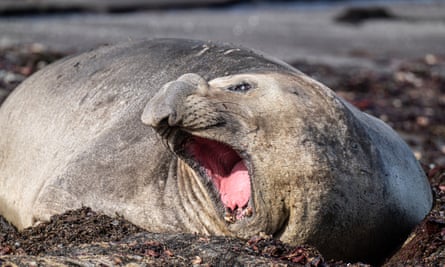
“Antarctica lives a curious, paradoxical existence,” said Dodds. “Goodwill sustains the treaty system, yet there is also this extraordinary sensitivity to what everyone else is doing.”
A year ago, tensions reached a head at the annual Antarctic treaty consultative meeting held in Berlin. Of the consultative parties, 23 expressed support for Ukraine, and there was even an unprecedented walkout during a meeting involving Russian delegates.
Antarctica accounts for about one-tenth of our planet’s land surface – equivalent to the combined area of Europe and the mainland US. About 70% of the Earth’s fresh water is locked in the glaciers and ice shelves that ring the continent.
It is one of the wildest, least-known places left on the planet. Inland, ferocious katabatic winds can reach speeds of 200mph . In 1983, a record low temperature of -89.6C was recorded at Russia’s Vostok station on the East Antarctic ice sheet. And beneath towering domes, ice caps and glaciers – some with names, others just bearing letters and numbers – lie unexplored subglacial lakes.
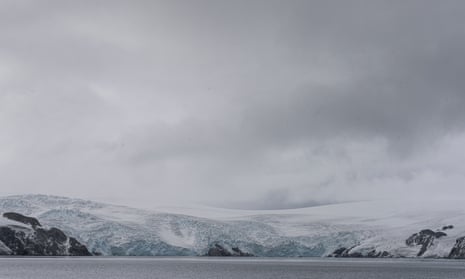
“I fell in love with the colours: the whites, the blues, and the way that the sky looks when the sun is low,” said Dr Amber Annett, 39, a Canadian marine biogeochemist at the University of Southampton.
Annett first came to the Antarctic in 2007, and was part of a majority-women scientific party onboard the British research vessel RRS Sir David Attenborough this year – her seventh expedition to the far south.
Today, the continent looks markedly different to what one US admiral described as “the womanless white continent of peace” in the 1960s. Many Antarctic missions are addressing equality, representation and safety at bases, and the issue has found its way on to the agenda at ATS meetings.
“I’ve been to some beautiful places elsewhere on the planet,” said Annett. “But this just feels so natural, because it doesn’t have much of a human stamp on it.”

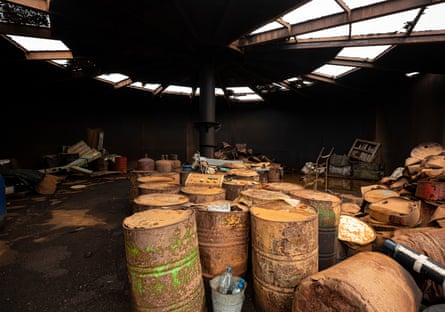
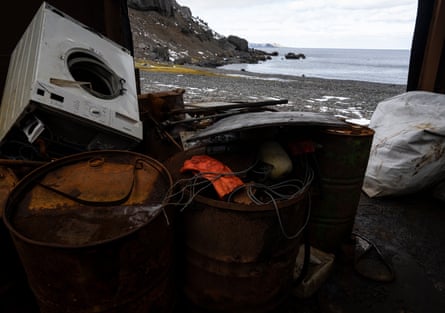

What human activity there is on Antarctica is concentrated, however, making the vast continent feel quite claustrophobic at times.
One of the most frenetic spots is King George Island on the Antarctic peninsula, a backbone of rock geologically related to the Andes in South America, where weather conditions shift so quickly that plans change minute by minute.
Argentina, Brazil, Chile, China, Poland, Russia, South Korea and Uruguay all have year-round bases there. Others maintain summer-only stations.
Beyond the many scientists who travel to Antarctica, tourist numbers are also shooting up. This summer, a record 106,000 visitors came to the Antarctic on more than 50 vessels. Regulating their entry and mitigating the impact of their activity is a headache yet to be fully reckoned with.
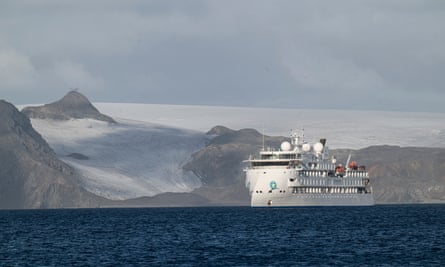
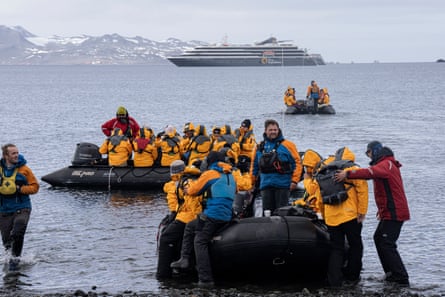
The human footprint is becoming increasingly apparent: microplastics were detected in Antarctic sea ice for the first time in 2020, and the impact of the climate crisis is being felt across the continent. The Antarctic peninsula is heating up five times faster than the global average. Since 1950, the area has warmed almost 3C.
One person with a unique perspective on this trend is the marine biologist Dr Sylvia Earle, 87. “I have not been here as a continuous witness to change, but I have been exploring our oceans longer than most,” she said, stepping off a boat bearing her name in an auburn bobble hat.
Earle first travelled to Antarctica in 1990 aboard a C-130 Hercules, landing at the US’s sprawling McMurdo station on the southern tip of Ross Island. She has lived underwater on 10 submarine missions, logged more than 7,000 diving hours and has held the world record for deepest untethered sea walk since 1979, when she walked on the bed of the Pacific Ocean, 381 metres below the surface.
“To see rivers of water gushing from the glaciers, and hearing that the ice shelves I saw on my first visit are now reduced to giant icebergs is very worrying.”
Fildes Bay plays host to overlapping territorial claims by Argentina, Chile and the UK, and shelters Villa Las Estrellas, a tiny village home to Chile’s navy, air force and the Escudero scientific base.
Until 2018, there was a school for the handful of families who would travel to live with partners stationed there. The sports hall even doubled up as a voting centre during Chile’s constitutional plebiscite.
David Cortés, 52, the village’s garrulous banker, also runs a minuscule branch of Banco BCI.

“What do I find hardest about being here?” he asked himself with a chuckle, swinging back on his office chair. “The nights, probably,” he responded knowingly. “There are just a couple of hours of daylight at the height of winter and your brain doesn’t know what to do.”
In the depths of winter, when Villa Las Estrellas is buried beneath 3 metres of snow, Cortés will often dig his way out of his dormitory block to the bank for his 9am shift, then lock up again at 1pm and tunnel back to base – without seeing a single client.

Most of his work involves passing cash to air force members for them to buy snacks from the canteen, which sells everything from pisco and Jägermeister to Cheetos and menthol cigarettes.
As well as passing psychological exams and medical and dental checks, Alfredo Muñoz, 56, a Chilean air force nurse from the blustery Patagonian city of Punta Arenas, who is settling in for his third Antarctic winter, was required to have his appendix removed, to avoid complications in the remote village.
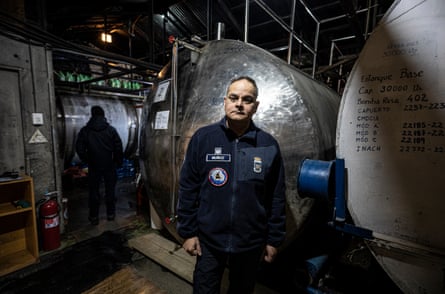
“After the pandemic, social activities with other bases have all but stopped,” he said.
He remembers inter-base football and volleyball matches, fancy dress parties and the midwinter sports competition between the various over-winter missions on King George Island.
Veterans of past Antarctic campaigns also recall invitations to the South Korean base across the bay for karaoke, or to China’s Great Wall station for lavish meals.
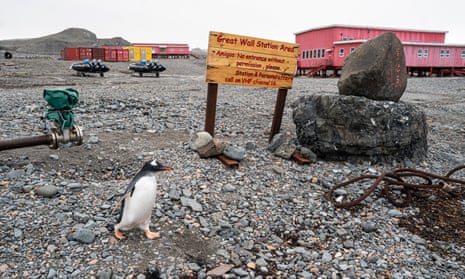
But the Covid pandemic put paid to much of this interaction, adding to the isolation. To limit interaction, a lorry was parked across the gravel track leading to the Chinese station, and even now there is little radio contact with the base, where neon lights pricking the gloom from a hilltop greenhouse are the only sign of life.
At Escudero base, scientists still find time to wind down in the laboratories after work with tequila shots from test tubes or whisky chilled with million-year-old ice plucked from Fildes Bay.
The scientists living and working on King George Island tend to avoid discussing geopolitical developments such as the war in Ukraine. Language differences mean that the working party at Russia’s nearby Bellingshausen station have long kept themselves to themselves.
Perched atop a scree hill north of the village, a Russian Orthodox church keeps watch over Villa Las Estrellas. It was built in 2002 from wood shipped from the Siberian city of Altay and its bells were brought from Vladimir, a city east of Moscow.
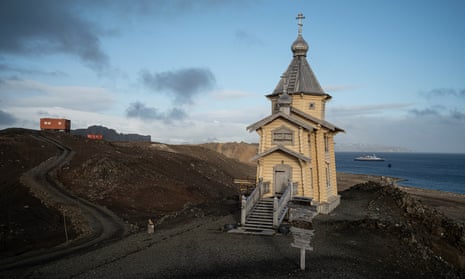
Mitrofan Soldatenko, 47, was born in Izhevsk, west of the Ural Mountains. After two years of military service in Siberia, he joined a male-only monastic community on Mount Athos in Greece. Three years ago, Soldatenko, a tall, polite man with piercing blue eyes, a thick beard and short ponytail, was posted to Antarctica, and he has not left Russia’s Bellingshausen station since.


He works as a carpenter and wiles away hours reading in his fragrant, wood-panelled kitchen, drinking cups of mint tea he makes from a sack of dried leaves.
Soldatenko deals with the cold, dark winters better than most. “I was born in winter,” he says, squeezing past a dark wedge of winter coats obstructing the entrance to the container home he shares with two colleagues next to the church.
“When I see snow and wind, I like it. I go outside, why would I stay in the house?”

But between social activities and work commitments, some have struggled with the isolation and short winter daylight hours. At the height of winter, visitors can find themselves spending days inside with their colleagues – and their thoughts.
During his second Antarctic winter in 2018, Muñoz, the Chilean nurse, treated a Russian scientist who was stabbed by a colleague outside the Bellingshausen station, reportedly because he kept revealing the endings of the books his colleague was reading.
Muñoz keeps himself busy by doubling up as the priest at a small Catholic church, and even used his last Antarctic winter to complete a diploma in palliative care by mail.
“To be honest, you just keep your head down and fall into a rhythm,” he said. “After all, where are you going to go?”
This article was amended on 5 May 2023. An earlier version referred to Sylvie Earl holding the world free dive record. In fact her world record is in a different category, that of the deepest untethered sea walk.



